Unsure about your French table manners? Click Here to download > > How to avoid these 10 food etiquette mistakes !
- Home ›
- Ze French ›
- La Gastronomie ›
- French Restaurant Menus
30 Surprising Things You’ll See On A French Restaurant Menu
Published 02 June 2025 by Leyla Alyanak — Parisian by birth, Lyonnaise by adoption, historian by passion
Eating in a French restaurant can be filled with delight — and a few surprises. Whether it’s an unexpected ingredient, a cultural custom, or an unfamiliar term, here’s what to watch out for on a French restaurant menu (and how to navigate it without scandal).
When you sit down at a café or bistro in France, you may feel confident about navigating the menu — until you open it.
That’s when the surprises begin: unfamiliar ingredients, unexpected customs, and a few culinary curveballs you never saw coming.
But don’t worry. You don’t have to be fluent in French or a food critic to handle a French menu like a pro. You just need a little guidance.
Your French restaurant menu - decoded
This guide tries to provide a basic overview of what you might find on your restaurant menu in France and highlight things that might be confusing.
Unusual dishes and ingredients
1. Andouillette is a strongly scented sausage made from pork intestines. The smell alone has ended many a tourist meal but those who love it (like me) can't get enough of it, especially if it's smothered in a creamy mustard sauce. You can find more delicacies like this in my guide to weird French foods.
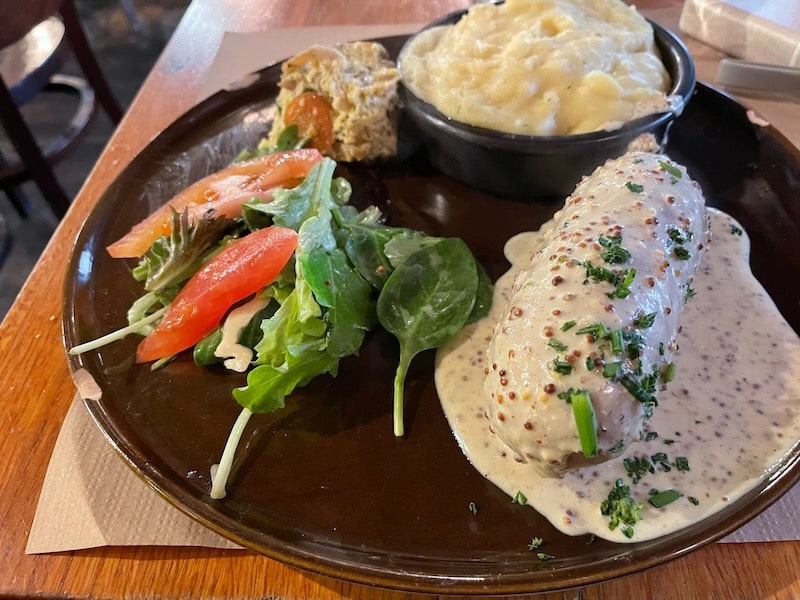 Andouillette: first, an acquired taste; then, irresistible! ©OffbeatFrance
Andouillette: first, an acquired taste; then, irresistible! ©OffbeatFrance2. Tête de veau, or calf’s head, includes tongue and cheek and is often served with sauce ravigote, made with capers. It’s part of France’s nose-to-tail tradition.
3. Confit de canard is a specialty from the Gascony region. It features duck leg slow-cooked in its own fat until tender, then crisped before serving. It's a beloved classic that showcases French skills of preserving flavor. Very fatty and just as beloved
4. Ratatouille is a Provençal vegetable stew that combines eggplant, zucchini, bell peppers and tomatoes, seasoned with herbs. It's a staple of southern French cuisine and offers a hearty vegetarian option.
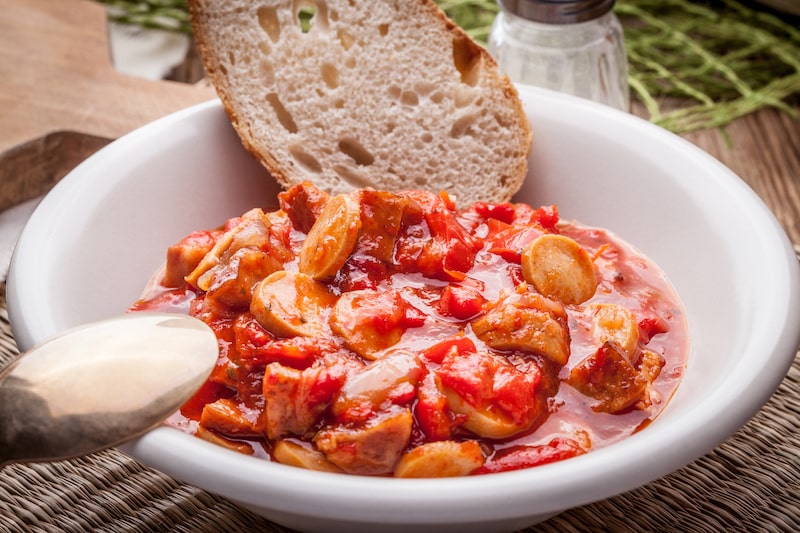 Delightful southern ratatouille
Delightful southern ratatouille5. Bouillabaisse, originating from Marseille, is a rich stew that includes various types of fish, simmered with herbs and served with rouille sauce and crusty bread topped with shredded cheese, as in French onion soup. It's a fine example of the variety of foods you'll find in southern France and along the Riviera.
6. Steak tartare has been known to shatter illusions about French food: it is raw minced beef mixed with egg yolk, herbs and spices, and many a foreigner has been heard trying to send it back to the kitchen for cooking. This request is rarely successful. If you like sushi, you might just enjoy it.
7. Rognons (kidneys in mustard sauce) may appear on classic bistro menus. Brace yourself. It's not an easy dish for first-timers, a bit like trying tripe or brains.
8. Boudin noir, or blood sausage, is rich and often served with apples — a traditional French comfort food which is a lot tastier than it sounds. Come winter, I always prepare a batch. It's so easy to make!
9. Escargots are snails baked in garlic-parsley butter. The garlic often wins over even the most skeptical tasters. What is it that makes escargots so special?
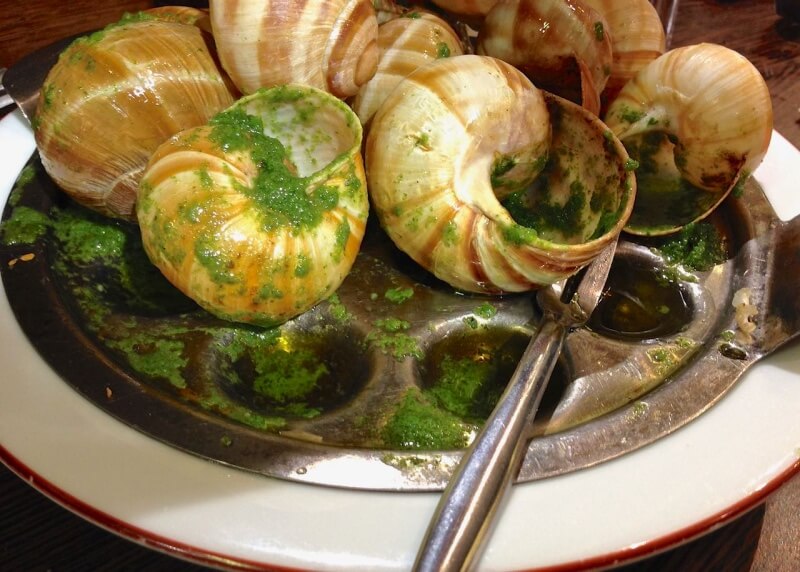 Escargots, or snails. Not to everyone's liking, but when you do, you can't stop eating them! ©OffbeatFrance
Escargots, or snails. Not to everyone's liking, but when you do, you can't stop eating them! ©OffbeatFrance10. Foie gras is nearly sacred here. You’ll see it in everything from burgers to salads, and especially during French Christmas meals.
11. French cheeses sometimes contain unpasteurized milk, giving them intense flavor and getting them banned abroad. Perfect for French picnics. For more rich, wintry options, see my Alpine cheese board.
Dining customs
12. Breakfast is minimalist and may not be what you think. Mostly, we eat pastry, tartines, coffee. Bacon and eggs? Not usually. Here's what a typical French breakfast looks like.
13. The basic French meal follows a certain pre-determined rhythm: you begin with a starter (entrée), a main dish (plat principal), cheese, dessert, and finally coffee. Entrée in France means starter.
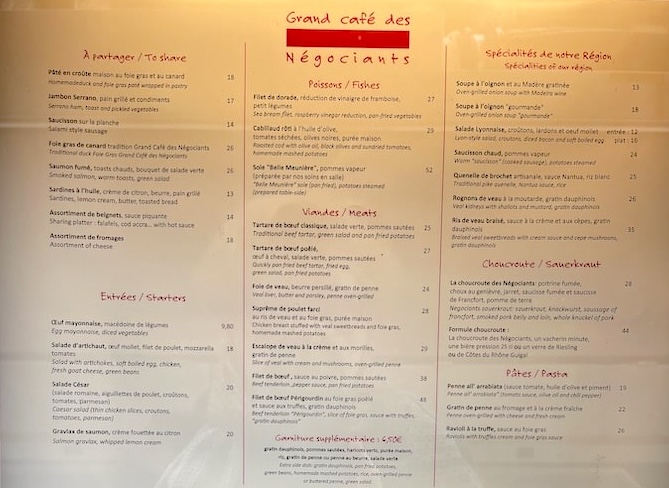
14. Before meals, apéritifs like kir (white wine with crème de cassis), pastis (anise-flavored spirit) or champagne are designed to stimulate the appetite.
15. The standard bread at a meal is the baguette. Bread is often placed directly on the tablecloth rather than on a side plate. It's meant to accompany the meal rather than serve as a starter. Bread typically comes without butter — except in Brittany or Normandy. Curious about our French breads? You can download my list of French breads here.
16. When ordering meat, cuisson levels range from bleu (barely seared) to très bien cuit (very well done). If you don’t specify, expect it pink.
17. Salads like salade landaise or chèvre chaud are anything but light and constitute a main meal, especially in summer or for lunch. Avoid cutting salad leaves with a knife; instead, fold them with your fork.
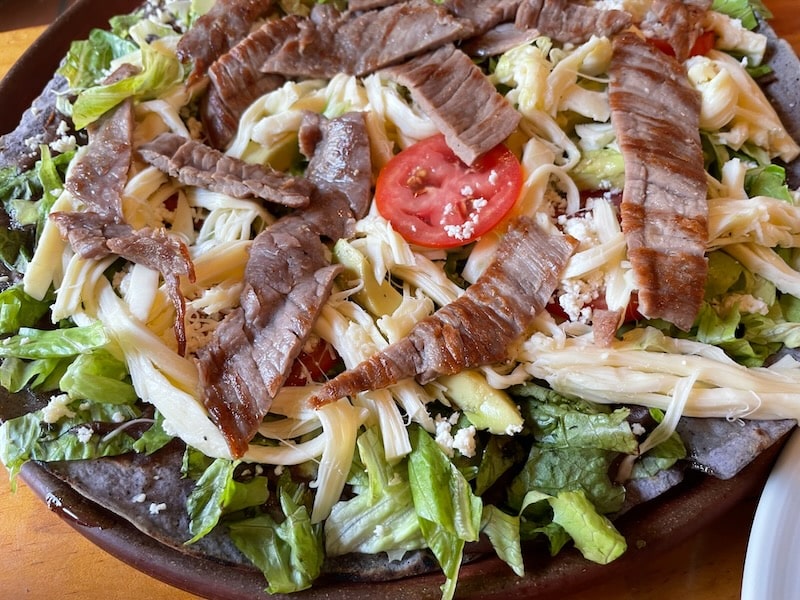 Some salads, especially with meat, can easily be a full meal
Some salads, especially with meat, can easily be a full meal18. Order a café, or coffee, and you’ll get a small espresso. For a longer drink, ask for a café allongé. Coffee comes after dessert. If you want both, order a café gourmand, a coffee served with a side of small pastries or mini-desserts, often smaller versions of some of those served on the menu.
19. Post-meal, digestifs such as Cognac, Armagnac, or Calvados are served to aid digestion and conclude the dining experience on a warm note.
French restaurant dining etiquette
20. Substitutions are frowned upon. The chef is always right. It's a lot harder to find a chef than a customer...
21. Ice is rarely added to drinks unless you specifically request it, and even then, just one or two cubes.
22. Ketchup isn’t standard with fries. Ask nicely but don't be surprised if this raises an eyebrow (unless you have children in tow or are eating a burger).
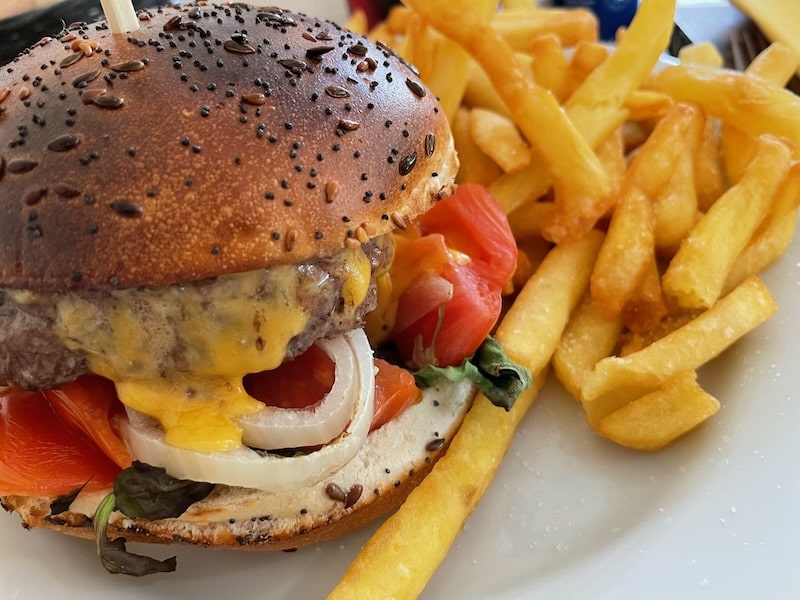 The hamburger has become ubiquitous in France - a study shows 85% of restaurants offer some kind of burger. Of course, ketchup under these circumstances is perfectly acceptable
The hamburger has become ubiquitous in France - a study shows 85% of restaurants offer some kind of burger. Of course, ketchup under these circumstances is perfectly acceptable23. Tap water is free. Ask for une carafe d’eau or risk paying for bottled.
24. In French dining etiquette, it's customary to keep your hands (but not elbows) on the table during meals.
25. Is service included in a French restaurant? A service charge is included, but small tips for good service are appreciated. See my full guide on tipping in France, because overtipping can be frowned upon.
26. Doggy bags became officially accepted in 2021, though some restaurants still seem surprised when you ask. Legally, you're entitled to it.
Menus and ordering
27. Plat du jour means today’s main dish. It's not necessarily a bargain, but at least it's usually seasonal and fresh.
28. Restaurants often offer unprinted suggestions. These may be displayed on a blackboard or slate, or simply in the waiter's mind, so do ask about les suggestions du jour.
29. What you consider the lunch and dinner menu is, in France, la carte. A menu is something else altogether: a fixed-price set of courses. Many restaurants offer a "menu du jour", often featuring seasonal dishes. The list of options may seem long, but you have to choose one dish per course. The word "ou" means OR.
30. Beware the vegetarian options: they may contain meat or have been cooked in beef broth or other animal products. France is traditionally meat-centric, so always ask, although these days, vegetarian and vegan options are increasingly available.
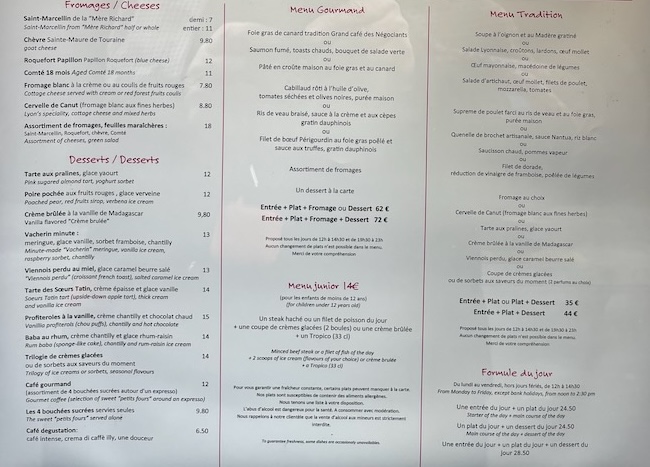
Useful French dining phrases
USEFUL FRENCH DINING PHRASES
- Do you have a table for two [# of people] please?
Avez-vous une table pour deux [#] s'il vous plait? - I'd like to reserve a table for two.
Je voudrais réserver une table pour deux personnes, s'il vous plait. - The bill, please.
L'addition, s'il vous plait. - A jug of tap water, please.
Une carafe d'eau, s'il vous plait.
Before you go...
One question I often get asked is this: Do French restaurants have English menus?
Yes, if it is in a tourist area, but don't expect a translation in a traditional restaurant. Eating in France is as much about understanding the culture as enjoying the food. We have one of the world's most celebrated culinary cultures: not only is it rooted in tradition, but it is adapting to change and demonstrating its flexibility.
So go ahead, be curious — you might just surprise yourself as you sample some of the stranger items on our menus.
For a more structured approach and some explanations about foods and customs, try taking one of the many excellent food tours in Paris or Lyon.
Did you enjoy this article? I'd love if you shared it!

